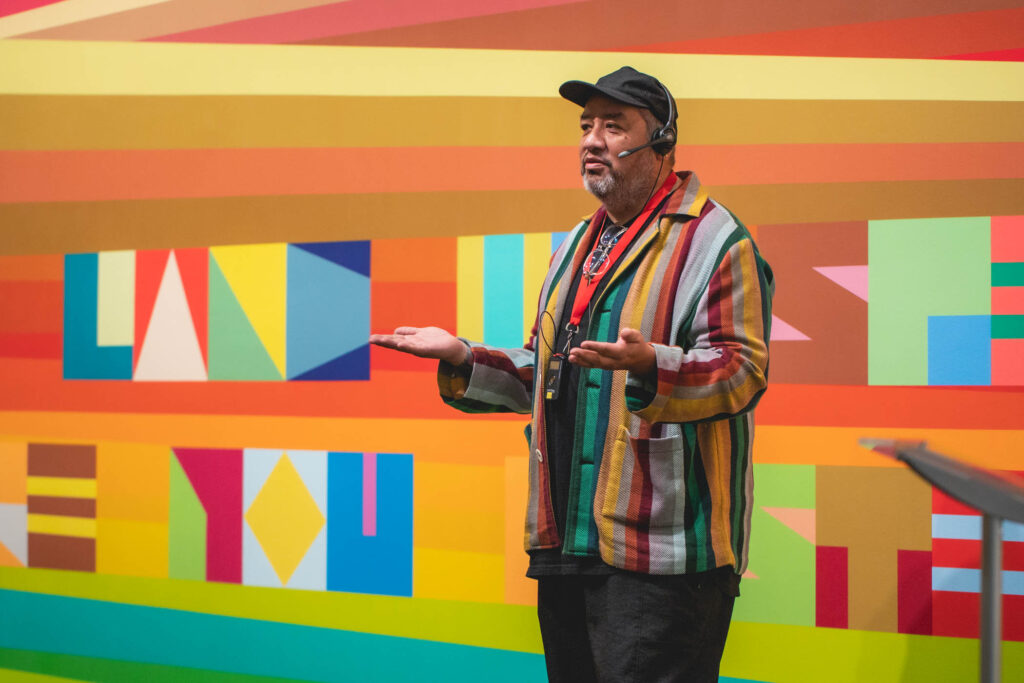An incredible convergence is about to take place in the winding alleyways of Venice, where the echoes of centuries past reverberate through the canals. The lively rhythm of jingle dress dancers will greet 26 intertribal Native American artists from Oklahoma and Colorado on April 18. Their trip through the narrow streets of the city will come to an end at the Giardini, amid the splendour of the United States Pavilion at the Venice Biennale.

Jeffrey Gibson, an acclaimed artist whose work connects culture, identity, and tradition, is at the centre of this show. Gibson incorporates stories of struggle and liberation into his artwork with a deft eye for historical detail and a creative spirit that pulsates. Born into a legacy of displacement and resilience his parents, survivors of poverty and the traumas of boarding schools, imparted upon him a complex heritage. It is from this set of experiences that Gibson draws inspiration, infusing his creations with layers of meaning and emotion. Jeffrey’s diverse influences and mediums comes from blending elements of domesticity, Native American heritage, and Hard-edge modernism.

His innovative approach involves painting on rawhide-clad wood panels, recycling found objects like antique mirrors and ironing boards, and incorporating materials such as untanned deer, goat, or elk skin. Gibson’s iconic punching bag sculptures, crafted from repurposed Everlast bags and adorned with glass beads and tin jingles, serve as a striking commentary on the intersection of mainstream pop culture and Native American powwow aesthetics. Among his notable works, pieces like “Document” and “Under Cover” showcase his mastery of acrylic and graphite on deer rawhide, while his “Atmospheric Landscapes” evoke ethereal realms through oil paint and pigmented silicon. In his “Totems” series, Gibson constructs whimsical sculptures using found objects like mannequins, toys, and flower pots, exploring themes of identity formation, cultural critique, and consumerism with a poignant blend of lyricism and introspection.

Seated at his studio amidst the picturesque scenery of upstate New York, Gibson considers his travels with a mix of seriousness and dry humour. His idea begins to take shape here, among the remnants of ongoing work for the Venice Biennale. Test flags, paint samples, and maquettes attest to the painstaking craftsmanship that goes into each piece, and Gibson manages the deadline with a cool head that belies the seriousness of his task. The upcoming show, “the space in which to place me,” will showcase Gibson’s artistic abilities and cultural relevance. Through a variety of media, including paintings, sculptures, videos, and flags, Gibson takes viewers on a contemplative and educational trip. Intricate beadwork, geometric patterns that are everywhere, and poetic writing come together to suggest Indigenous and larger American history, upending stereotypes and reclaiming stories that have been marginalised for a long time.

Gibson’s selection as the first Native artist to represent the U.S. with a solo exhibition in the Venice Biennale’s 94-year history is both a milestone and a culmination of his lifelong dedication to his craft. Collaborating with esteemed curators and drawing upon his Navajo heritage, Gibson breathes life into the pavilion, infusing it with a spirit of radical inclusivity and introspection. Yet, amidst the accolades and acclaim, Gibson remains grounded in his pursuit of authenticity and expression. His work, a vivid patchwork of colours and shapes, reflects his journey from the colourful LGBTQ culture that created his identity to the traditional Native items of his childhood. Gibson challenges us to acknowledge the complexity of the human experience and to challenge our preconceptions through layers of symbolism and metaphor.
As the Venice Biennale unfolds, Gibson’s art becomes a vessel for transformation—a space where narratives converge, identities intersect, and voices resonate. From the jingle dress dancers weaving through the streets of Venice to the towering figures adorned with ancestral spirits, Gibson’s vision spans the confines of space and time, inviting us toreimagine our place in the world.
Feature Image: Jeffrey Gibson. Courtesy: Frist Art Museum






